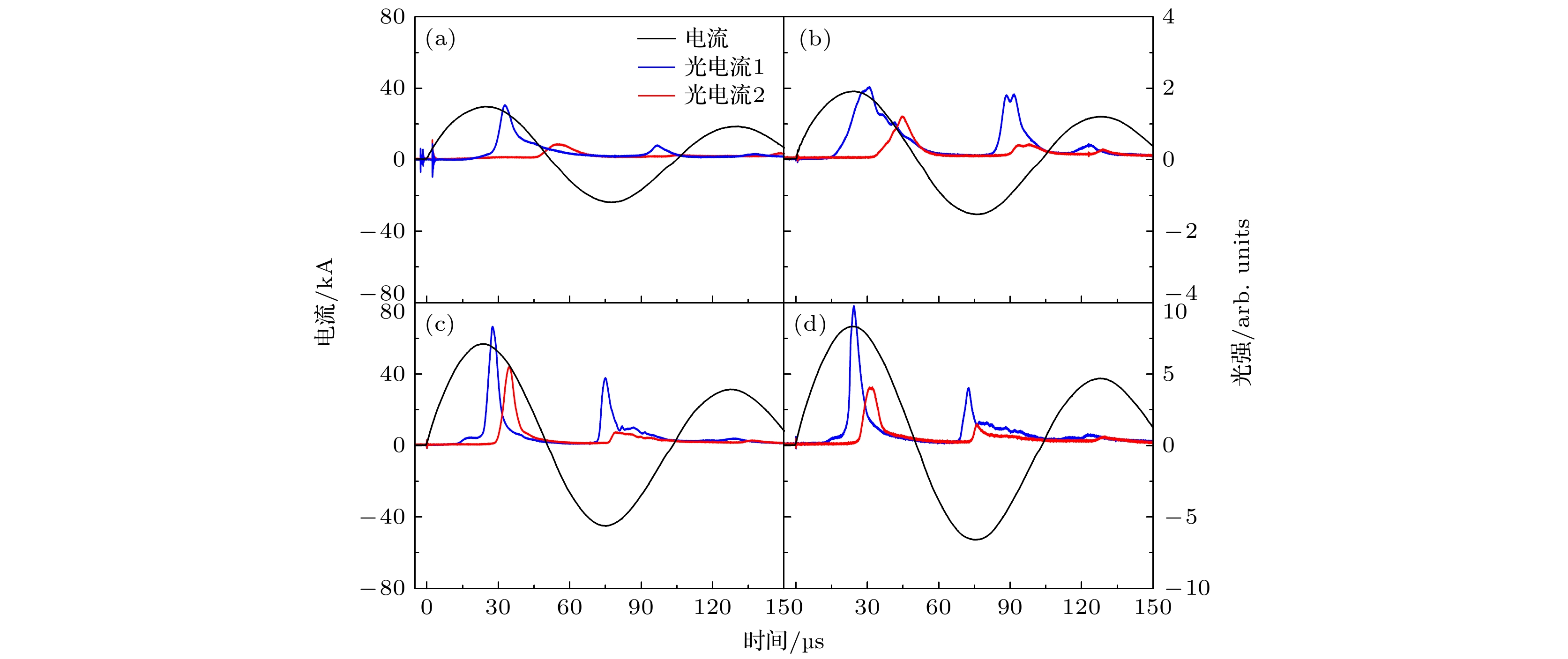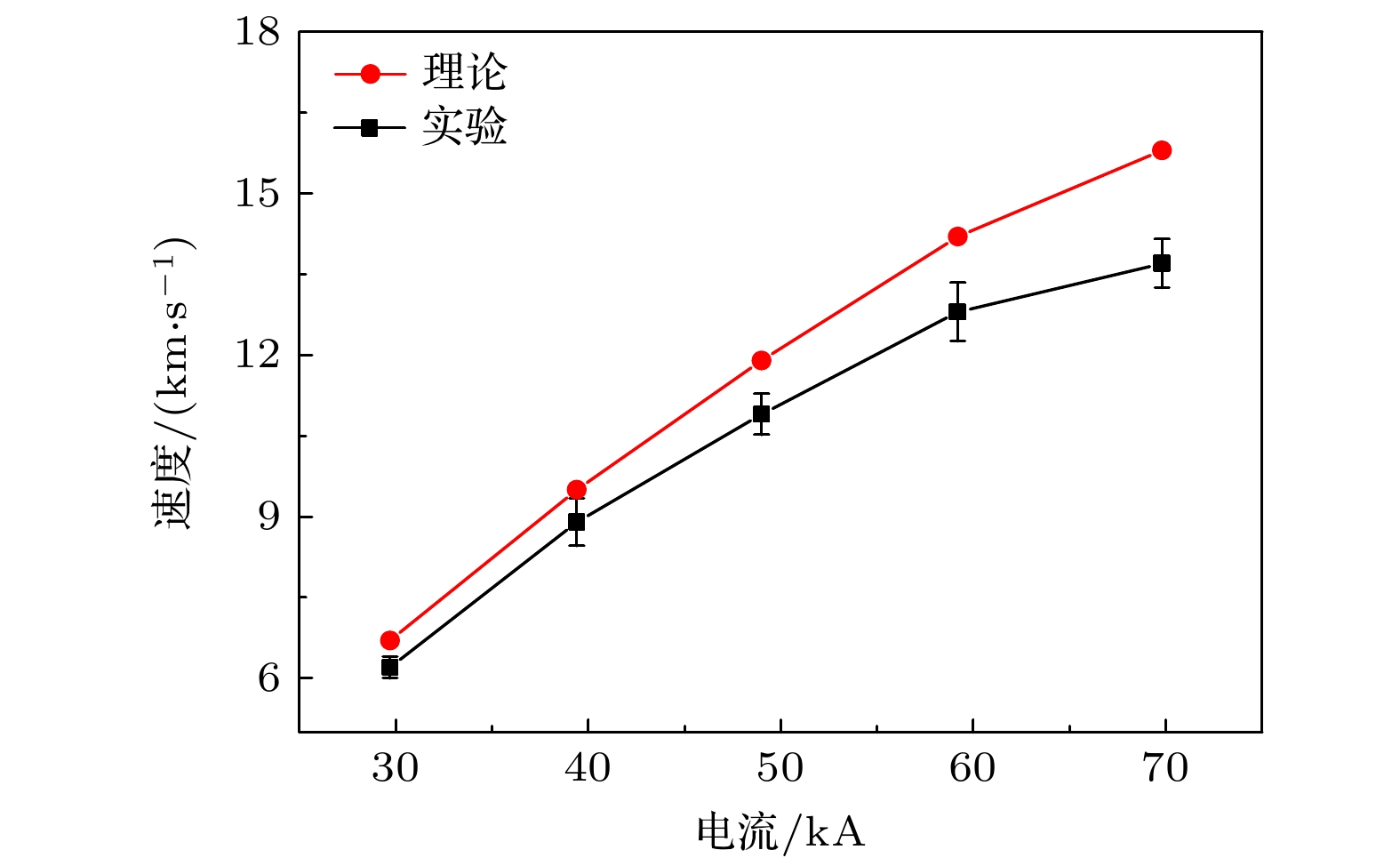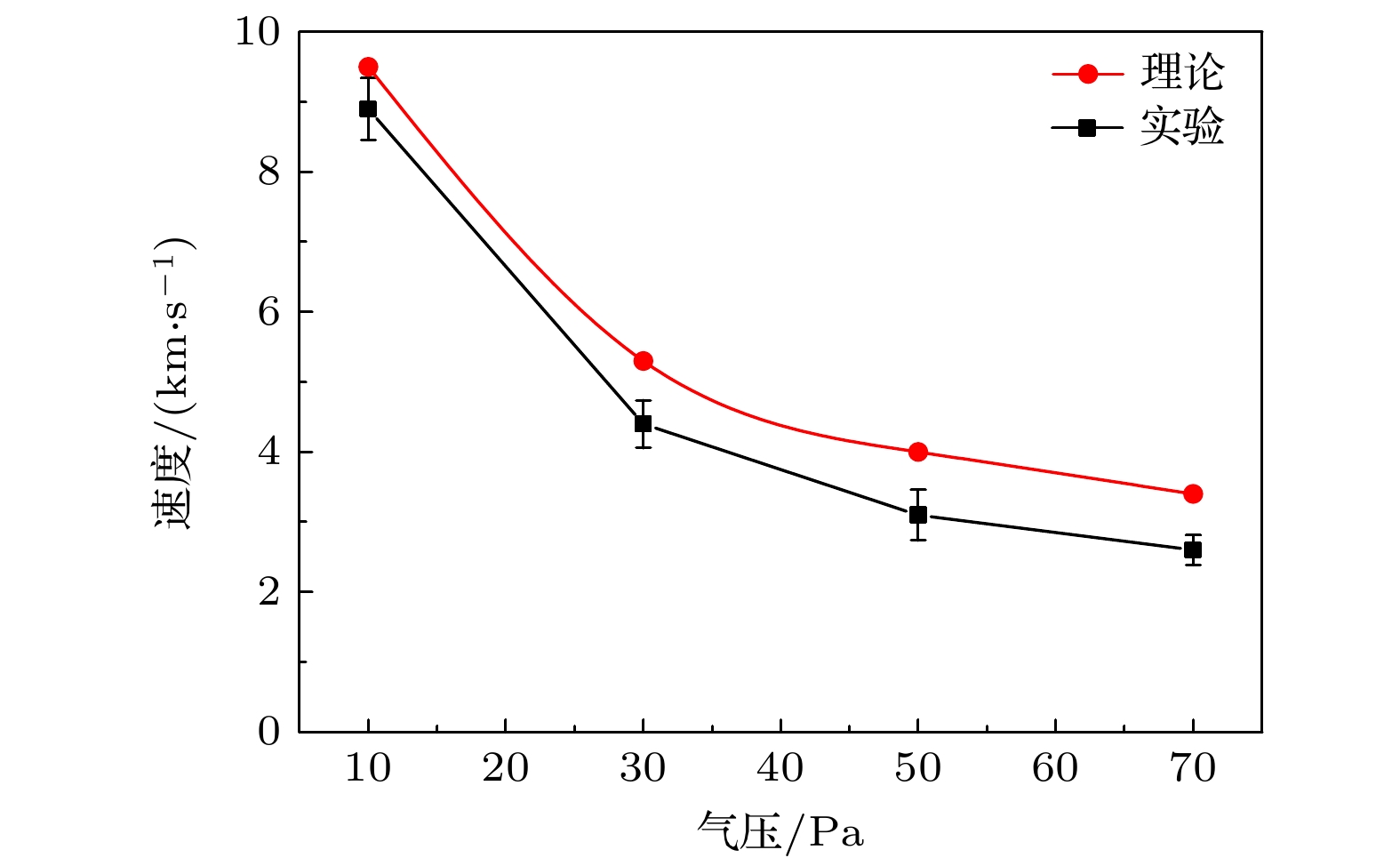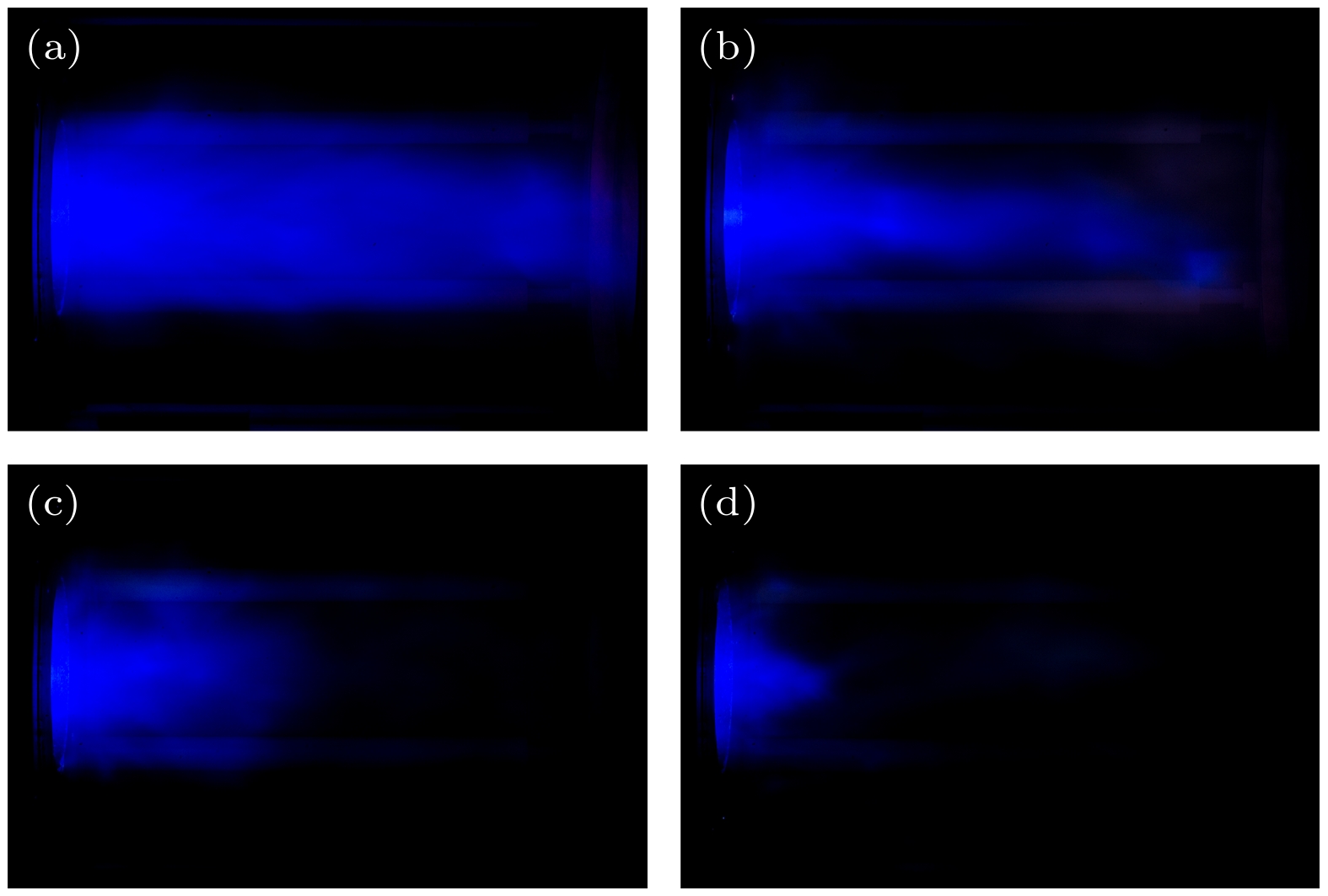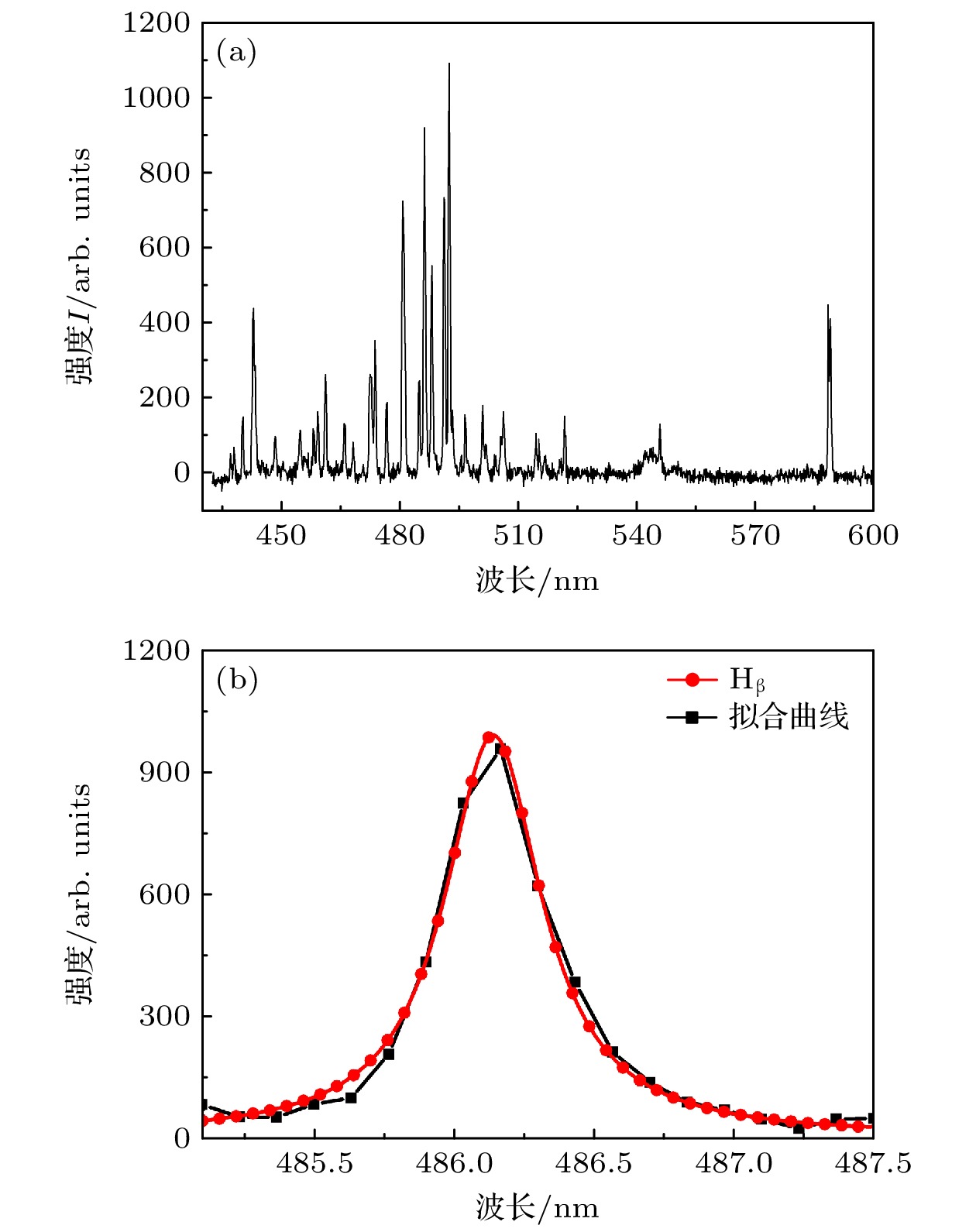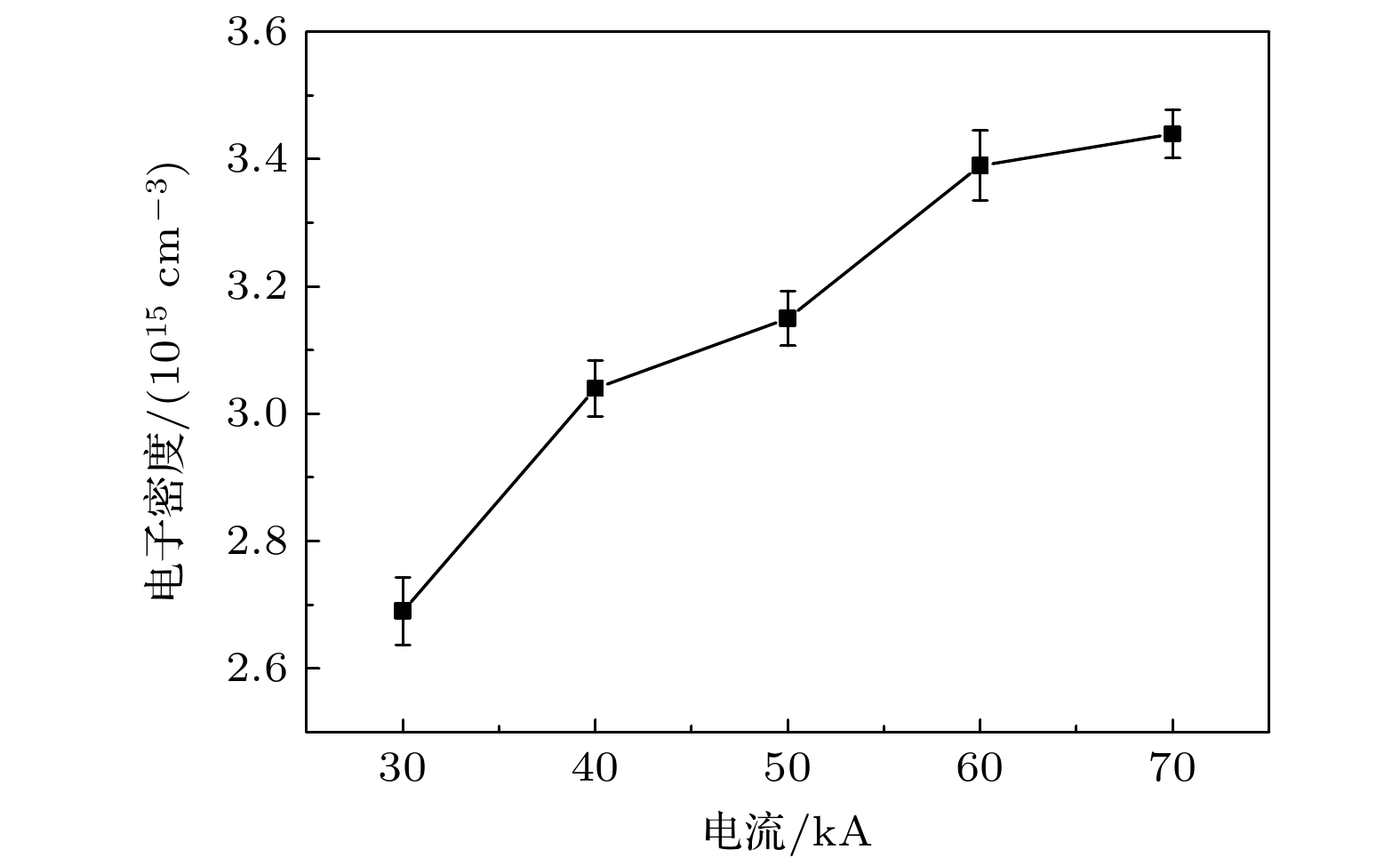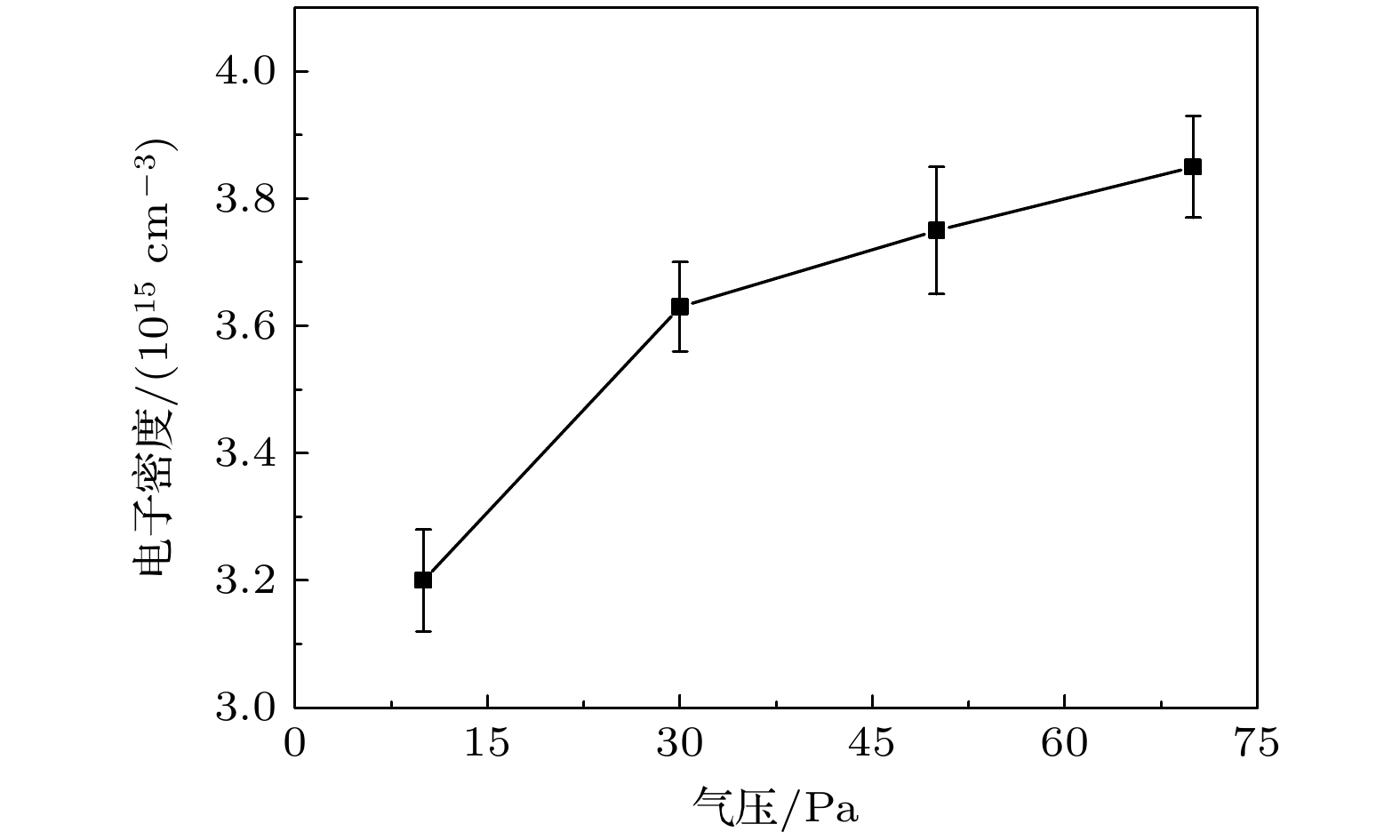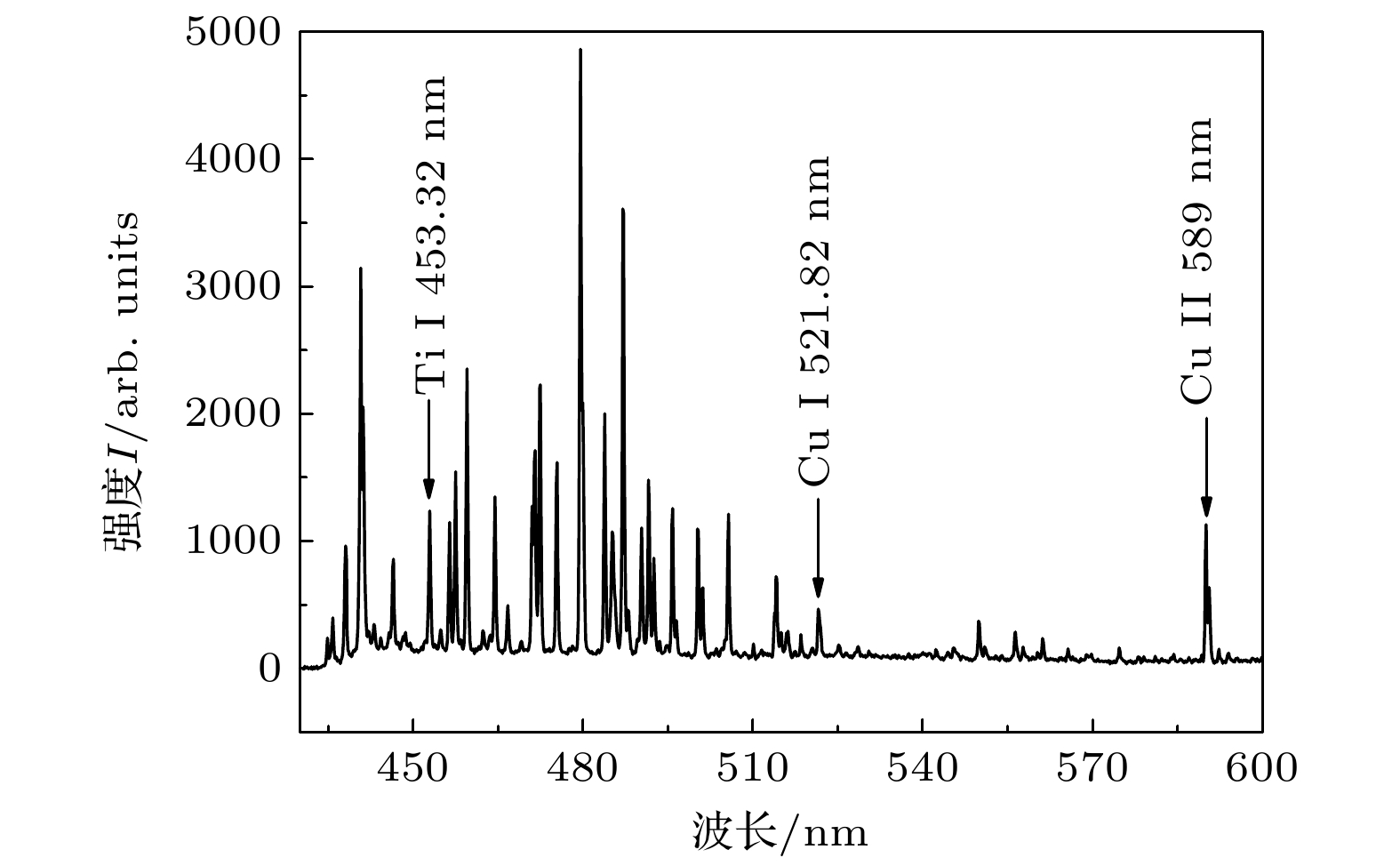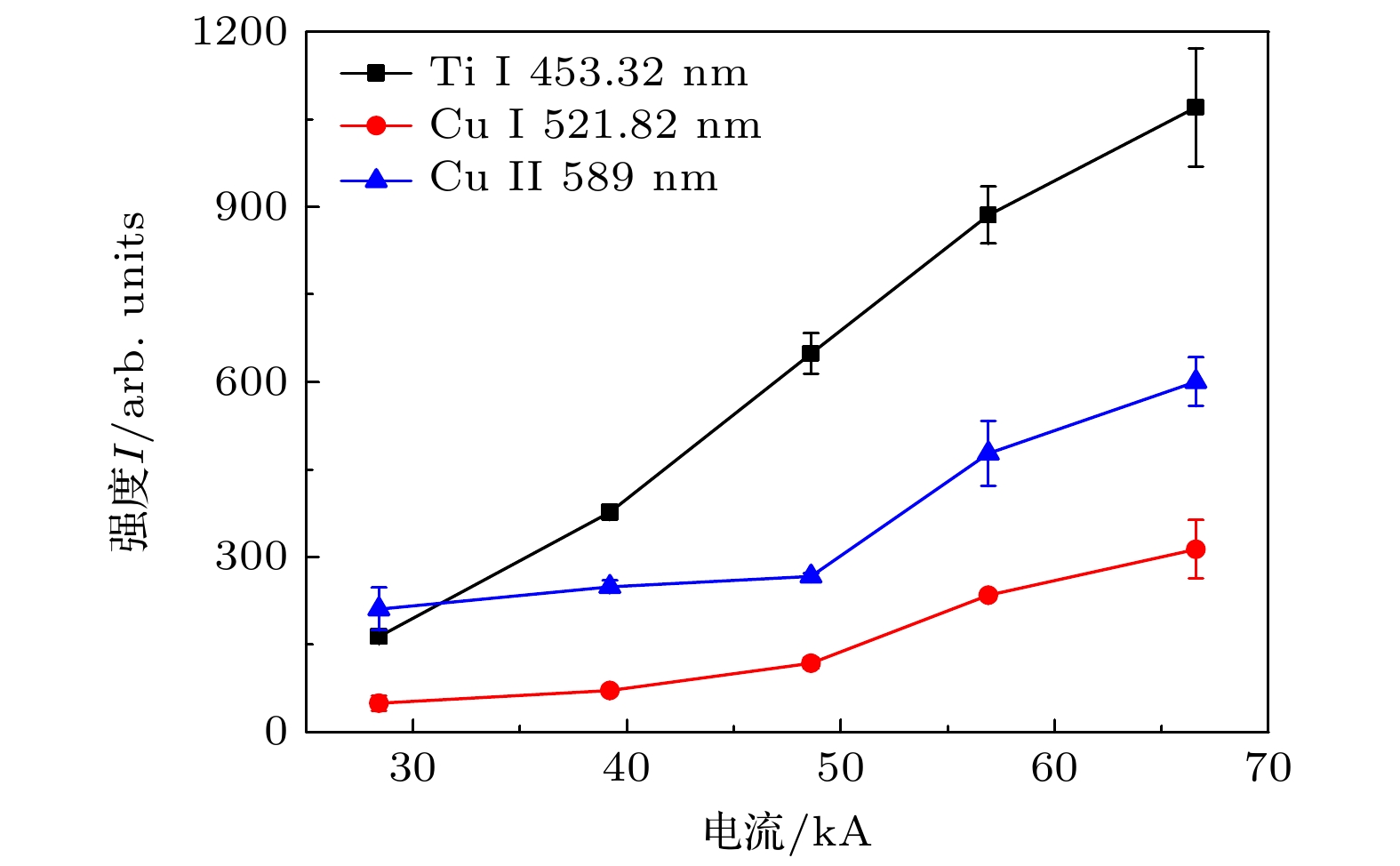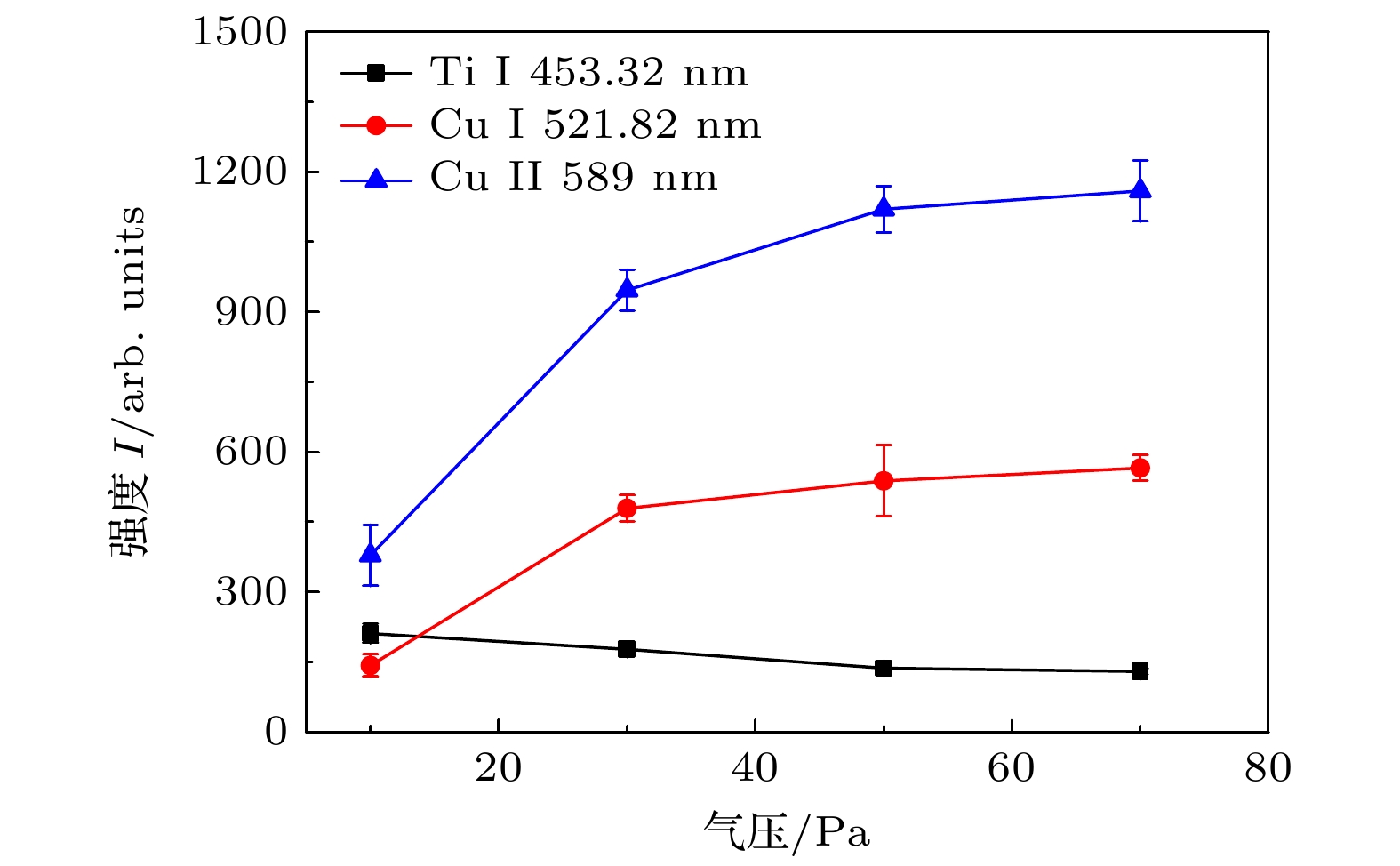-
同轴枪放电可以产生高速度、高密度及高能量密度的等离子体射流, 在等离子体空间推进、天体物理和高温核聚变等研究领域具有广泛的应用. 基于同轴枪的实际应用, 等离子体速度、密度、纯净度是评估等离子体特性的重要参量. 本文通过对等离子体光电流信号和发射光谱的测量及放电图像的拍摄, 研究了不同放电电流和气压对同轴枪放电等离子体的动力学特性、电子密度与杂质发射光谱的影响. 实验结果表明: 气压为10 Pa, 放电电流为30—70 kA时, 等离子体在枪内的加速时间随电流的增大而缩短, 等离子体中阳极和阴极杂质光谱均随电流的增大而增强; 放电电流为40 kA, 气压为10—70 Pa时, 等离子体加速时间随气压的增大而增长, 等离子体中阴极杂质光谱强度随气压的增加不断降低, 而阳极杂质光谱强度却是逐渐增加的, 不过其增长速率逐渐减小. 分析认为, 不同放电电流和气压决定了等离子体获能、加速特性及电子密度, 协同影响金属杂质特性. 同轴枪喷口处发生等离子体箍缩效应与高密度电弧在枪内加速时间是影响阳极烧蚀的重要因素, 阴极材料的杂质是离子轰击溅射产生的, 主要依赖于离子携带的能量.
The coaxial gun discharge can produce plasma jet with high velocity, high density and high energy density, and has extensive applications, such as in plasma space propulsion, simulation of the interaction between edge local mode and wall materials in ITER, fuel injection in magnetic confinement fusion devices, and laboratory astrophysics. In the pre-filled discharge mode or snowplow mode, the plasma current sheet is formed near the insulating layer surface and moves toward the end of the coaxial gun under Lorentz force. Plasma velocity, density and purity characteristics are very important research contents for the actual applications of coaxial gun. Emission spectrometry as a non-interference method can be used to diagnose a variety of plasma physical properties. In this experiment, the effects of different discharge currents and gas pressures on the plasma dynamics, electron density and impurity emission spectra of coaxial gun discharge plasma are studied through the measurement of plasma photocurrent, emission spectra and the shooting of discharge images. The experimental results show that the acceleration time of the plasma in the gun decreases with current increasing in a range of 30–70 kA when the gas pressure is 10 Pa, the spectral intensity of anode and cathode impurities in plasma increase with current amplitude increasing. When the discharge current is 40 kA and the gas pressure is in a range of 10–70 Pa, the acceleration time of plasma increases with gas pressure rising, and the spectral intensity of the cathode impurity in the plasma decreases with the pressure increasing, while the spectral intensity of the anode impurity increases gradually, but its growth rate decreases continuously. The analysis indicates that the presence of metallic impurities originating from the electrode material limits the jet velocity of the plasma and is the main cause of the deviation from theoretical value. The plasma pinch effect at the nozzle of coaxial gun and the acceleration time of high-density arc in the gun are important factors affecting anode ablation. The impurity of cathode material is produced by ion bombardment sputtering, which mainly depends on the energy carried by ions. Therefore, a reasonable choice for discharge parameters is the key factor to obtain optimal plasma characteristics during the discharge of the coaxial gun. -
Keywords:
- coaxial gun /
- plasma /
- photocurrent /
- emission spectrum
[1] Hammer J H, Hartman C W, Eddleman J L, McLean H S 1988 Phys. Rev. Lett. 61 2843
 Google Scholar
Google Scholar
[2] Hammer J H, Eddleman J L, Hartman C W, McLean H S, Molvik A W 1991 Phys. Fluids B 3 2236
 Google Scholar
Google Scholar
[3] Skvortsov Y V 1992 Phys. Fluids B 4 750
 Google Scholar
Google Scholar
[4] Black D C, Mayo R M, Gerwin R A, Schoenberg K F, Scheuer J T, Hoyt R P, Henins I 1994 Phys. Plasmas 1 3115
 Google Scholar
Google Scholar
[5] Sadowski M J, Scholz M 2008 Plasma Sources Sci. Technol. 17 024001
 Google Scholar
Google Scholar
[6] Baker K L, Hwang D Q, Evans R W, Horton R D, McLean H S, Terry S D, Howard S, DiCaprio C J 2002 Nucl. Fusion 42 94
 Google Scholar
Google Scholar
[7] Tereshin V I, Bandura A N, Byrka O V, Chebotarev V V, Garkusha I E, Landman I, Makhlaj V A, Neklyudov I M, Solyakov D G, Tsarenko A V 2007 Plasma Phys. Controlled Fusion 49 A231
 Google Scholar
Google Scholar
[8] 高著秀, 冯春华, 杨宣宗, 黄建国, 韩建伟 2012 61 145201
 Google Scholar
Google Scholar
Gao Z X, Feng C H, Yang X Z, Huang J G, Han J W 2012 Acta Phys. Sin. 61 145201
 Google Scholar
Google Scholar
[9] Hsu S C, Moser A L, Merritt E C, Adams C S, Dunn J P, Brockington S, Case A, Gilmore M, Lynn A G, Messer S J, Witherspoon F D 2014 J. Plasma Phys. 81 345810201
 Google Scholar
Google Scholar
[10] Wiechula J, Schoenlein A, Iberler M, Hock C, Manegold T, Bohlender B, Jacoby J 2016 AIP Adv. 6 075313
 Google Scholar
Google Scholar
[11] Zhang Y, Fisher D M, Gilmore M, Hsu S C, Lynn A G 2018 Phys. Plasmas 25 055709
 Google Scholar
Google Scholar
[12] Woodall D M, Len L K 1985 J. Appl. Phys. 57 961
 Google Scholar
Google Scholar
[13] 漆亮文, 赵崇霄, 闫慧杰, 王婷婷, 任春生 2019 63 035203
 Google Scholar
Google Scholar
Qi L W, Zhao C X, Yan H J, Wan T T, Ren C S 2019 Acta Phys. Sin. 63 035203
 Google Scholar
Google Scholar
[14] Poehlmann F R 2010 Ph. D. Dissertation (Stamford: Stanford University
[15] 赵崇霄, 漆亮文, 闫慧杰, 王婷婷, 任春生 2019 68 105203
 Google Scholar
Google Scholar
Zhao C X, Qi L W, Yan H J, Wan T T, Ren C S 2019 Acta Phys. Sin. 68 105203
 Google Scholar
Google Scholar
[16] Kikuchi Y, Nakanishi R, Nakatsuka M, Fukumoto N, Nagata M 2010 IEEE Trans. Plasma Sci. 38 232
 Google Scholar
Google Scholar
[17] Parks P B 1988 Phys. Rev. Lett. 61 1364
 Google Scholar
Google Scholar
[18] Rabiński M, Zdunek K 2003 Vacuum 70 303
 Google Scholar
Google Scholar
[19] Rabiński M, Zdunek K 2007 Surf. Coat. Technol. 201 5438
 Google Scholar
Google Scholar
[20] 杨亮, 张俊龙, 闫慧杰, 滑跃, 任春生 2017 66 055203
 Google Scholar
Google Scholar
Yang L, Zhang J L, Yan H J, Hua Y, Ren C S 2017 Acta Phys. Sin. 66 055203
 Google Scholar
Google Scholar
[21] 刘帅, 黄易之, 郭海山, 张永鹏, 杨兰均 2018 67 065201
 Google Scholar
Google Scholar
Liu S, Huang Y Z, Guo H S, Zhang Y P, Yang L J 2018 Acta Phys. Sin. 67 065201
 Google Scholar
Google Scholar
[22] Wang Z, Beinke P D, Barnes C W, Michael W M, Mignardot E, Wurden G A, Hsu S C, Intrator T P, Munson C P 2005 Rev. Sci. Instrum. 76 033501
 Google Scholar
Google Scholar
[23] Brown M R, Bailey Iii A D, Bellan P M 1991 J. Appl. Phys. 69 6302
 Google Scholar
Google Scholar
[24] Chow S P, Lee S, Tan B C 1972 J. Plasma Phys. 1 21
 Google Scholar
Google Scholar
[25] Wiechula J, Hock C, Iberler M, Manegold T, Schönlein A, Jacoby J 2015 Phys. Plasmas 22 043516
 Google Scholar
Google Scholar
[26] Qian M Y, Ren C S, Wang D Z, Zhang J L, Wei G D 2010 J. Appl. Phys. 107 063303
 Google Scholar
Google Scholar
[27] Ashkenazy J, Kipper R, Caner M 1991 Phys. Rev. A 43 5568
 Google Scholar
Google Scholar
[28] Zhao C X, Song J, Qi L W, Ma C Y, Hu J J, Bai X D, Wang D Z 2020 Fusion Eng. Des. 158 111870
 Google Scholar
Google Scholar
[29] Liu S, Huang Y Z, Zhang Y P, Zhan W, Yu M H, Yang L J 2018 Phys. Plasmas 25 113505
 Google Scholar
Google Scholar
[30] 宋健, 李嘉雯, 白晓东, 张津硕, 闫慧杰, 肖青梅, 王德真 2021 70 105201
 Google Scholar
Google Scholar
Song J, Lee J W, Bai X D, Zhang J S, Yan H J, Xiao Q M, Wang D Z 2021 Acta Phys. Sin. 70 105201
 Google Scholar
Google Scholar
[31] Chau S W, Hsu K L, Lin D L, Tzeng C C 2007 J. Phys. D: Appl. Phys. 40 1944
 Google Scholar
Google Scholar
-
-
[1] Hammer J H, Hartman C W, Eddleman J L, McLean H S 1988 Phys. Rev. Lett. 61 2843
 Google Scholar
Google Scholar
[2] Hammer J H, Eddleman J L, Hartman C W, McLean H S, Molvik A W 1991 Phys. Fluids B 3 2236
 Google Scholar
Google Scholar
[3] Skvortsov Y V 1992 Phys. Fluids B 4 750
 Google Scholar
Google Scholar
[4] Black D C, Mayo R M, Gerwin R A, Schoenberg K F, Scheuer J T, Hoyt R P, Henins I 1994 Phys. Plasmas 1 3115
 Google Scholar
Google Scholar
[5] Sadowski M J, Scholz M 2008 Plasma Sources Sci. Technol. 17 024001
 Google Scholar
Google Scholar
[6] Baker K L, Hwang D Q, Evans R W, Horton R D, McLean H S, Terry S D, Howard S, DiCaprio C J 2002 Nucl. Fusion 42 94
 Google Scholar
Google Scholar
[7] Tereshin V I, Bandura A N, Byrka O V, Chebotarev V V, Garkusha I E, Landman I, Makhlaj V A, Neklyudov I M, Solyakov D G, Tsarenko A V 2007 Plasma Phys. Controlled Fusion 49 A231
 Google Scholar
Google Scholar
[8] 高著秀, 冯春华, 杨宣宗, 黄建国, 韩建伟 2012 61 145201
 Google Scholar
Google Scholar
Gao Z X, Feng C H, Yang X Z, Huang J G, Han J W 2012 Acta Phys. Sin. 61 145201
 Google Scholar
Google Scholar
[9] Hsu S C, Moser A L, Merritt E C, Adams C S, Dunn J P, Brockington S, Case A, Gilmore M, Lynn A G, Messer S J, Witherspoon F D 2014 J. Plasma Phys. 81 345810201
 Google Scholar
Google Scholar
[10] Wiechula J, Schoenlein A, Iberler M, Hock C, Manegold T, Bohlender B, Jacoby J 2016 AIP Adv. 6 075313
 Google Scholar
Google Scholar
[11] Zhang Y, Fisher D M, Gilmore M, Hsu S C, Lynn A G 2018 Phys. Plasmas 25 055709
 Google Scholar
Google Scholar
[12] Woodall D M, Len L K 1985 J. Appl. Phys. 57 961
 Google Scholar
Google Scholar
[13] 漆亮文, 赵崇霄, 闫慧杰, 王婷婷, 任春生 2019 63 035203
 Google Scholar
Google Scholar
Qi L W, Zhao C X, Yan H J, Wan T T, Ren C S 2019 Acta Phys. Sin. 63 035203
 Google Scholar
Google Scholar
[14] Poehlmann F R 2010 Ph. D. Dissertation (Stamford: Stanford University
[15] 赵崇霄, 漆亮文, 闫慧杰, 王婷婷, 任春生 2019 68 105203
 Google Scholar
Google Scholar
Zhao C X, Qi L W, Yan H J, Wan T T, Ren C S 2019 Acta Phys. Sin. 68 105203
 Google Scholar
Google Scholar
[16] Kikuchi Y, Nakanishi R, Nakatsuka M, Fukumoto N, Nagata M 2010 IEEE Trans. Plasma Sci. 38 232
 Google Scholar
Google Scholar
[17] Parks P B 1988 Phys. Rev. Lett. 61 1364
 Google Scholar
Google Scholar
[18] Rabiński M, Zdunek K 2003 Vacuum 70 303
 Google Scholar
Google Scholar
[19] Rabiński M, Zdunek K 2007 Surf. Coat. Technol. 201 5438
 Google Scholar
Google Scholar
[20] 杨亮, 张俊龙, 闫慧杰, 滑跃, 任春生 2017 66 055203
 Google Scholar
Google Scholar
Yang L, Zhang J L, Yan H J, Hua Y, Ren C S 2017 Acta Phys. Sin. 66 055203
 Google Scholar
Google Scholar
[21] 刘帅, 黄易之, 郭海山, 张永鹏, 杨兰均 2018 67 065201
 Google Scholar
Google Scholar
Liu S, Huang Y Z, Guo H S, Zhang Y P, Yang L J 2018 Acta Phys. Sin. 67 065201
 Google Scholar
Google Scholar
[22] Wang Z, Beinke P D, Barnes C W, Michael W M, Mignardot E, Wurden G A, Hsu S C, Intrator T P, Munson C P 2005 Rev. Sci. Instrum. 76 033501
 Google Scholar
Google Scholar
[23] Brown M R, Bailey Iii A D, Bellan P M 1991 J. Appl. Phys. 69 6302
 Google Scholar
Google Scholar
[24] Chow S P, Lee S, Tan B C 1972 J. Plasma Phys. 1 21
 Google Scholar
Google Scholar
[25] Wiechula J, Hock C, Iberler M, Manegold T, Schönlein A, Jacoby J 2015 Phys. Plasmas 22 043516
 Google Scholar
Google Scholar
[26] Qian M Y, Ren C S, Wang D Z, Zhang J L, Wei G D 2010 J. Appl. Phys. 107 063303
 Google Scholar
Google Scholar
[27] Ashkenazy J, Kipper R, Caner M 1991 Phys. Rev. A 43 5568
 Google Scholar
Google Scholar
[28] Zhao C X, Song J, Qi L W, Ma C Y, Hu J J, Bai X D, Wang D Z 2020 Fusion Eng. Des. 158 111870
 Google Scholar
Google Scholar
[29] Liu S, Huang Y Z, Zhang Y P, Zhan W, Yu M H, Yang L J 2018 Phys. Plasmas 25 113505
 Google Scholar
Google Scholar
[30] 宋健, 李嘉雯, 白晓东, 张津硕, 闫慧杰, 肖青梅, 王德真 2021 70 105201
 Google Scholar
Google Scholar
Song J, Lee J W, Bai X D, Zhang J S, Yan H J, Xiao Q M, Wang D Z 2021 Acta Phys. Sin. 70 105201
 Google Scholar
Google Scholar
[31] Chau S W, Hsu K L, Lin D L, Tzeng C C 2007 J. Phys. D: Appl. Phys. 40 1944
 Google Scholar
Google Scholar
计量
- 文章访问数: 3492
- PDF下载量: 73
- 被引次数: 0














 下载:
下载:
